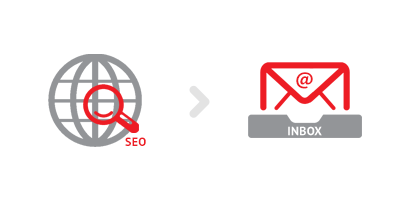Six email deliverability lessons that you can learn from SEO
Search engine optimisation and email marketing are two completely different parts of online marketing mix. One might say that email marketing is the last resort of the online domain where SEO has no role. But the two aren’t totally unrelated, so what can you learn from SEO to improve your deliverability?
Web versions aside, emails obviously can’t be publicly indexed by Google. So you don’t have to heavily optimise your emailings for search engines. And when it comes to email deliverability you can just ignore SEO.
Or can you? While it may be true that search engines don’t index emails (yet), that doesn’t mean there aren’t any lessons email marketers can learn from SEO.
Here’s six techniques borrowed from SEO that’ll help you improve your email deliverability:
1. Keep your coding simple
Search engines are not able to crawl flash content, and often have trouble with other types of coding like JavaScript. Email clients work in the same way, most of them don’t accept any form of scripting.
The majority of the clients aren’t able to load emails that are composed with scripts. Scripts can also result in email delivery issues.
That’s why you have to keep it simple. When building an email template, steer away from JavaScript and stick to HTML. If you have to use CSS, make sure you do it the right way.
If you personalise emails, make sure that once the email is sent, it is fully rendered in HTML, for instance by using an email friendly mail merge language like Smarty.
Also, always include a text version of your newsletter for email clients that aren’t even able to read HTML.
2. Use pre headers
Any smart content producer or webmaster will create meta descriptions for their web pages, allowing search engines to give their users a sneak peek of the content in their search results. Although meta descriptions might not directly influence a website’s page ranking anymore, they do play an important role in increasing the click through rate from the search engine to your pages.
In email there is the pre header or email snippet, it’s like the meta description of your email. This is the text someone sees in the inbox, underneath or next to the subject line. When left blank, the pre header will show something like:
- Can’t read this email? Open the web version.
- You are receiving this email because you signed up for...
This of course will not help improve your email open rate. But when set up correctly, an appealing pre header can invite the recipient to open your email, increasing your open rate and thus improving your email send reputation.
3. Find a good balance between images and text
In SEO text is more effective better than images because search engines are unable to recognise the content of an image. But if you use the right images, it can add a lot to your content. The same goes for email, images and visual stimuli can add a lot of emotion to your emails.
Using too many images and too little text in an email can however lead to email delivery issues, because email clients aren’t able to recognise the content in your email and are more likely to filter it.
Keep the text versus images ratio balanced. And if you use images, don’t forget to add alt and title tags to your HTML source.
4. Choose your keywords wisely
Choosing the right keywords is one of the most important factors in SEO. The same goes for email deliverability, as many email clients use these words to determine whether you might be a potential spammer.
Avoid profanities at all cost, and although this is a discussion point in email deliverability land, it is advised to monitor deliverability closely when using words like ‘free’ or ‘special offer’ in your email’s subject line.
5. Be recognisable
Authorship mark-up is one of the SEO new kids on the block that’s making a name for itself pretty fast. Content producers are claiming authorship to their content in increasing numbers. Recognised authorship is expected to be one of the key SEO drivers in the near future, and author portraits in the search results are already boosting click through rates.
When it comes to email marketing, being recognisable is even more important. In email reputation is everything and for a receiving party to be able to check your identity, you should always set up your authentication data correctly.
6. Be relevant
Last but certainly not least. All techniques aside, the best way to get a good page ranking is to produce relevant content. Google and other search engines are always improving their algorithms to be able to serve their users the right search results. So as long as your main focus is adding value, in the long run that is the best SEO strategy possible.
The same goes for email marketing. Relevancy is the most valuable asset you have to improve your email deliverability. When you send relevant content, recipients won’t hit the ‘Mark as spam’ button.
Relevant content also ensures that people will open your emails, improving your email reputation and in the end, your conversions.


















